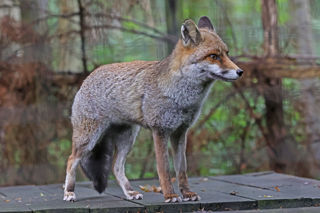
Red Fox
Vulpes vulpes
The red fox is the only wild member of the dog family remaining in the UK. They are a medium sized canid; their height averages 40cm at the shoulder and their weight averages 5-8kg. They have a distinct bushy tail, rusty orange/red coat with a white underside, and pointed ears with black tips.
Behaviour
Red foxes are crepuscular animals; most active at dusk and dawn. Their social groups can be made up of breeding males and females, and cubs. They scent mark their territories using urine and mark trails using scent glands on their feet. They create burrows and shelters in water banks, among tree roots, or any abandoned human environment.
Due to their highly social nature, communication is key and takes a number of different forms, from body language and displays to a wide vocal repertoire, such as barking and screeching during the mating period.
UK Status
Red foxes are widespread except the Scottish Islands, Channel Islands, Isles of Scilly and Isle of Man.
Threats
Their main threats are traffic incidences and human persecution. They are often seen as pests and are controlled in many areas to prevent livestock and pet predation. The Hunting Act 2004 made fox hunting illegal in England and Wales. They also have legal protection under the Animal Welfare Act 2006.

Distribution
With the widest geographical range of any member of the carnivore family. Red foxes are found across the whole of the northern hemisphere, excluding Iceland and some parts of Siberia. They are an introduced species in the USA, Canada, Australia and various islands, such as the Falkland Islands. Territories can range from 25 hectares to as large as 4000 hectares when prey is scarce.
Habitat
The key to their huge distribution is their ability to adapt to many environments and habitats. They can inhabit urban gardens and cities, wetlands, coastland, woodland, arable land, mountainous regions, tundra), but natural habitat is regarded as dry mixed landscape areas with a lot of habitat edge features like scrub and woodlands. In the UK, their preferred habitat includes a mosaic patchwork pf scrub, woodland and farmland.
Diet
Being opportunistic omnivores, the red fox is a species that readily exploits any food source it can find. Small mammals such as rodents and rabbits are an important food source, but invertebrates (earthworms, beetles), birds and fruit are all noted as important food sources for the relevant populations. However, they are also known to scavenge from dustbins and other sources of discarded food waste.
Wildwood inside information
Our fox is pretty shy, not bold as brass like the foxes you see in your back gardens. You can find her just past the badger building and opposite the bears.
Family facts
Males foxes are called “dogs” and females are called “vixens”.
-
![Red Fox Sleeping]()
Wildwood animal adoptions last for one year and are the perfect gift for any animal lover. Each adoption helps support our work to save British wildlife. We have different levels of adoption available to suit all occasions and budgets.
ADOPT ME!
-
![Red Fox Standing]()
Find out how you can support our conservation work and join our fight.
Support us



